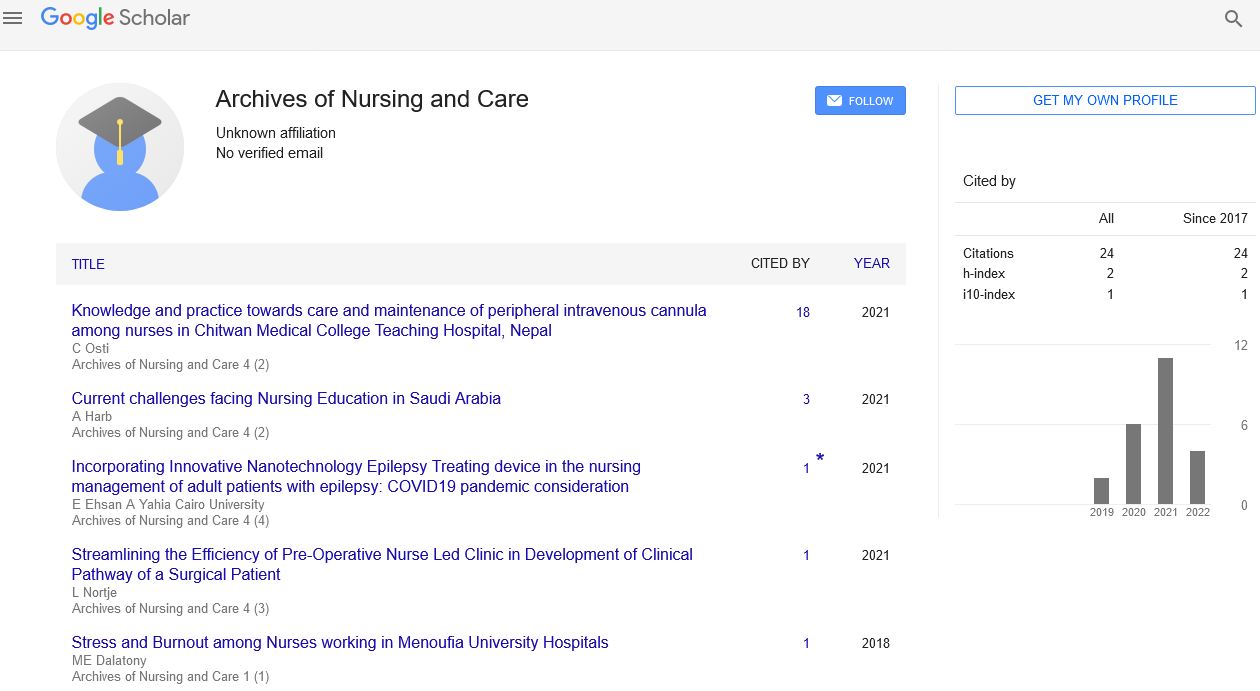Review Article - Archives of Nursing and Care (2023) Volume 6, Issue 4
Advancing Pediatric Critical Care: The Crucial Role of Antifungals in Invasive Fungal Infections
Rosie Felia*
Pediatric Infectious Diseases, Department of Pediatrics, St. Joseph’s Children’s Hospital, USA
Pediatric Infectious Diseases, Department of Pediatrics, St. Joseph’s Children’s Hospital, USA
E-mail: Feliarosie@edu.it.au
Received: 02-Aug-2023, Manuscript No. oanc-23-102710; Editor assigned: 04-Aug-2023, PreQC No. oanc-23- 102710 (PQ); Reviewed: 18-Aug- 2023, QC No. oanc-23-102710; Revised: 24-Aug-2023, Manuscript No. oanc-23-102710 (R); Published: 30-Aug-2023; DOI: 10.37532/ oanc.2023.6(4).109-111
Abstract
Invasive fungal infections pose a significant threat to pediatric patients in critical care settings, necessitating effective management strategies. Antifungal agents play a crucial role in the treatment of these infections, improving patient outcomes and reducing mortality rates. This abstract provides a concise overview of the role of antifungals in pediatric critical care for invasive fungal infections. It highlights the importance of early diagnosis and prompt treatment, discusses the various classes of antifungal agents commonly used, such as azoles, echinocandins, and amphotericin B, and emphasizes the need for tailored approaches in pediatric patients. The abstract concludes by emphasizing the importance of close collaboration among healthcare professionals to optimize antifungal therapy and the need for further research in this field to address emerging challenges and improve outcomes in pediatric critical care invasive fungal infections.
Keywords
Pediatric critical care • Invasive Fungal Infections • Pediatric patients
Introduction
Invasive fungal infections pose a significant threat to pediatric patients in critical care settings. These infections are associated with high mortality rates and can cause serious complications if not promptly diagnosed and treated. Antifungal agents play a crucial role in managing these infections, providing effective therapy and improving patient outcomes. This article explores the role of antifungals in pediatric critical care and highlights key considerations for their use in invasive fungal infections [1].
The three major pathogenic factors for the development of an IFI include compromised natural barriers resulting from mucositis, invasive procedures and indwelling catheters, defects in cell-mediated immunity related to T-cell cytotoxic agents and myelosuppression and decreased phagocytes as a result of chemotherapy [2]. High-risk groups for developing IFIs include patients undergoing hematopoietic stem cell transplantation (HCT) especially with an allogeneic donor; patients receiving chemotherapy for acute myeloid leukemia (AML) or relapsed acute lymphoblastic leukemia (ALL); and patients with severe aplastic anemia.
In pediatric oncology patients, with the availability of better chemotherapy protocols aiming at increased survival, there is a resultant risk of increase in serious and disseminated fungal infections even with ubiquitous and normally innocuous fungal pathogens. The intensive immunosuppressive regimens cause disruption of normal host defenses including mucosal barriers, thus predisposing to IFIs. Rheumatologic and connective tissue disorders needing immunosuppressive therapy, congenital immunodeficiency syndromes, and acquired immunodeficiency states like HIV/ AIDS are other predisposing conditions for developing IFIs [3].
Understanding invasive fungal infections
Invasive fungal infections occur when pathogenic fungi invade deep tissues or organs, leading to systemic disease. Common fungal pathogens in pediatric critical care settings include Candida species, Aspergillus species, and Mucormycetes. These infections often affect immunocompromised patients [4], such as those with prolonged hospital stays, oncologic disorders, or undergoing solid organ or hematopoietic stem cell transplantation.
The importance of early diagnosis and prompt treatment
Timely diagnosis of invasive fungal infections is crucial, as delayed initiation of appropriate therapy is associated with increased morbidity and mortality. Diagnostic modalities include blood cultures, radiological imaging, histopathology, and biomarkers like beta- D-glucan and galactomannan. The results of these tests, in conjunction with clinical suspicion, guide the initiation of antifungal therapy [5].
Antifungal agents in pediatric critical care
Azoles: Azole antifungals, such as fluconazole, voriconazole, and posaconazole, are widely used in the management of invasive fungal infections. They inhibit the synthesis of ergosterol, a key component of fungal cell membranes. Azoles are effective against Candida species, Aspergillus species, and some endemic fungi. However, their utility may be limited by drug-drug interactions and the emergence of antifungal resistance.
Once the decision to begin therapy is made, the next step in management is choosing the optimal regimen and dosing. This decision is driven by disease-based risk stratification, mechanism of action, spectrum of activity, pharmacological properties, and adverse effects/toxicities [6]. These include the polyene group that encompasses amphotericin B deoxycholate and its lipid formulations (liposomal amphotericin B, amphotericin B lipid complex, and amphotericin B cholesteryl sulfate complex); the nucleoside analogue flucytosine; the triazoles which include fluconazole and voriconazole; and the most recently developed echinocandin class, which includes caspofungin, micafungin, and anidulafungin.
Echinocandins: Echinocandins, including caspofungin, micafungin, and anidulafungin, target the fungal cell wall by inhibiting the synthesis of beta-glucans. These agents demonstrate excellent activity against Candida species, including azole-resistant strains, and are considered first-line therapy for invasive candidiasis. However, echinocandins have limited activity against Aspergillus species [7]. Amphotericin B: Amphotericin B, a polyene antifungal, binds to ergosterol in the fungal cell membrane, causing membrane disruption and cell death. Lipid formulations of amphotericin B, such as liposomal amphotericin B and amphotericin B lipid complex, are preferred due to their improved safety profile compared to conventional formulations. Amphotericin B remains a key agent for the treatment of invasive aspergillosis and Mucormycetes infections.
Combination therapy: In certain cases, combination therapy with different classes of antifungals may be considered, especially for critically ill patients with refractory infections or those at high risk for resistance. However, the benefits of combination therapy should be weighed against potential drug interactions, toxicities, and increased costs [8].
Despite its still less than optimal availability, use of antifungal susceptibility testing (AFST) in critical care constitutes an indispensable though challenging tool in IFI management. In the ever challenging world of managing IFI, determination of MICs is a proxy for antifungal agent efficacy and provides susceptibility information for local epidemiologic data and effective empiric antifungal choices. Drawbacks include limitations of common referenced AFST methods like Clinical Laboratory Standards Institute (CLSI) or European Committee on Antimicrobial Susceptibility Testing with its available commercial adaptations due to slow turnaround time. Additionally differing clinical breakpoints and their subjective interpretations, issues with correlation with efficacy and interreader subjectivity in visual MIC determination may lead to unreliable results in the clinical setting [9]. Newer nucleic acid-based technologies are becoming increasingly used for the detection of antifungal resistance and newer generation methods like genomic analysis may become a critical tool for predicting evolving population based epidemiologic patterns as well as tailored susceptibility and level of resistance.
Special considerations in pediatrics
When selecting antifungal therapy for pediatric patients, factors such as age, weight, renal and hepatic function, drug interactions, and adverse effects should be carefully considered. Dosing adjustments are often required in children to ensure optimal drug exposure. Close monitoring of drug levels, liver function, and renal function is necessary to guide dosing modifications and ensure therapeutic efficacy while minimizing toxicity [10].
Conclusion
Antifungal agents play a vital role in the management of invasive fungal infections in pediatric critical care. Early diagnosis, prompt initiation of appropriate therapy, and close monitoring of drug levels and toxicities are essential. Collaboration between infectious disease specialists, intensivists, and pharmacists is crucial for optimizing antifungal therapy in this vulnerable patient population. The increase in prevalence of IFI, antifungal agents is increasingly needed in the pediatric critical care setting. Each class has its advantages and first-line indications. Knowledge of spectrum of activity and indications of antifungals are imperative for prompt treatment of critically ill children with IFI. Further research and innovation in antifungal drug development are needed to address emerging resistance and improve outcomes for pediatric patients with invasive fungal infections.
References
- Januškevičius ZI, Stasiūnas AS.Transmission of physiologicalinformationby telephone.Cor Vasa. 5, 152-155 (1963).
- Balogh N, Kerkovits G, Horvath Let al.Cardiac digital image loops and multimedia reports over the internet using DICOM.StudHealthTechnol Inform. 90,148-151(2002).
- Berdusis K.The state of the art: tele-echocardiography and telecardiology.Telemed Today. 7, 25-6(1999).
- Crowe B, Hailey D.Cardiac picture archiving and communication systems and telecardiology – technologies awaiting adoption.J Telemed Telecare. 8, 3-11(2002).
- Yamamoto Y, Tsutsumi Y, Yoshioka Yet al.Site-specific PEGylation of a lysine-deficient TNF-alpha with full bioactivity.Nat Biotechnol.21, 546-552(2003).
- Kaneda Y, Kamada H, Yamamoto Yet al.The use of PVP as a polymeric carrier to improve the plasma half-life of drugs.Biomaterials.25, 3259-3266(2004).
- Tsunoda S, Kamada H, Yamamoto Yet al.Molecular design of polyvinylpyrrolidone-conjugated interleukin-6 for enhancement of in vivo thrombopoietic activity in mice.J Control Release68, 335-341(2000).
- Norouzinia R, Aghabarari M, Kohan Met al.Health promotion behaviors and its correlation withanxietyand some students’demographic factors of Alborz University of Medical Sciences.Journal ofHealthPromotion Management. 2(4), 39- 49(2013).
- Evangelista LS, Shinnick MA.What do we know about adherence and self-care?J Cardiovasc Nurs. 23, 250-257(2008).
- Heberer T.Occurrence, fate, and removal of pharmaceutical residues in the aquatic environment: A review of recent research data.Toxicol Lett.131, 5-17 (2002).
Indexed at, Google Scholar, Crossref
Indexed at, Google Scholar, Crossref
Indexed at, Google Scholar, Crossref
Indexed at, Google Scholar, Crossref
Indexed at, Google Scholar, Crossref

